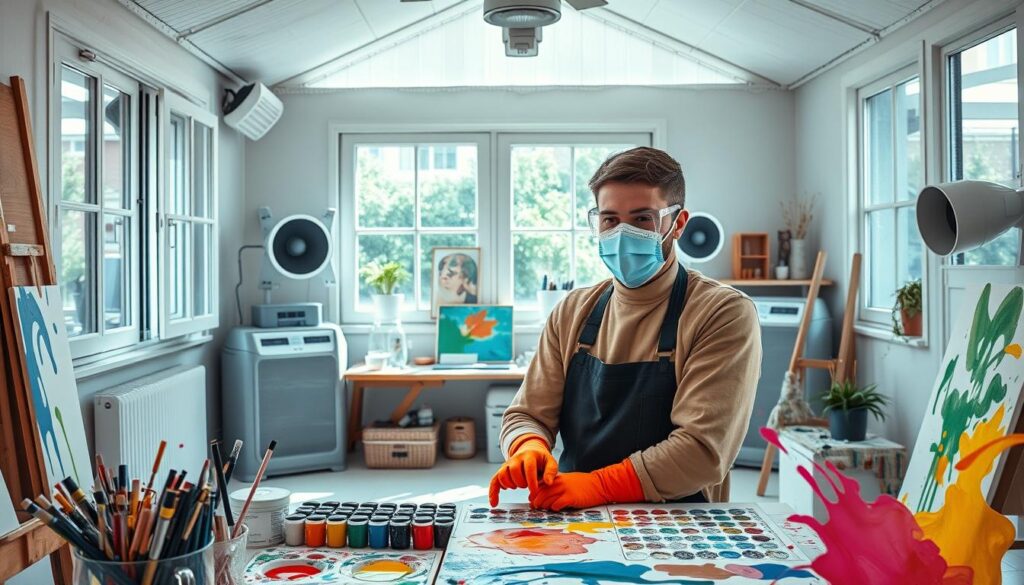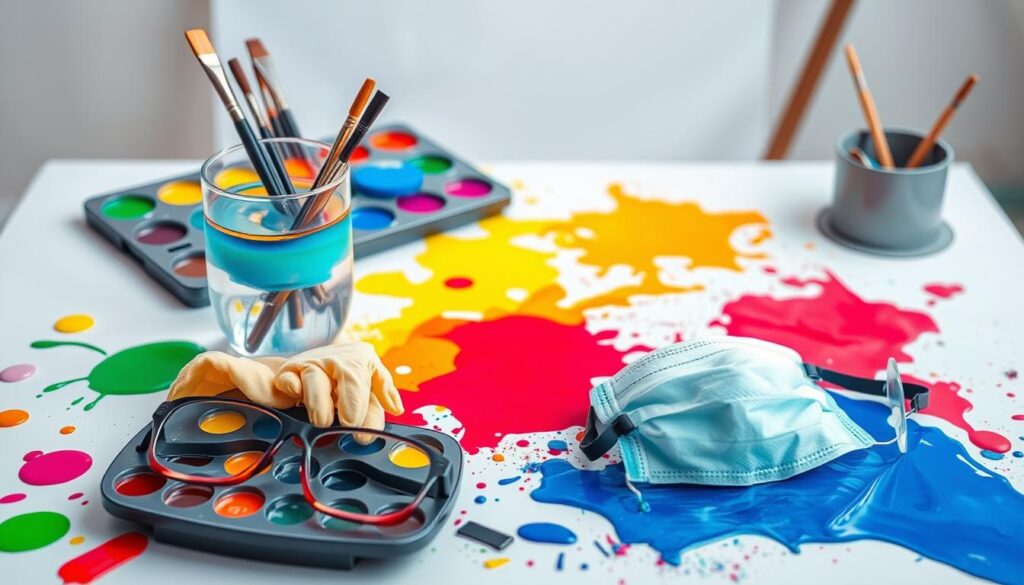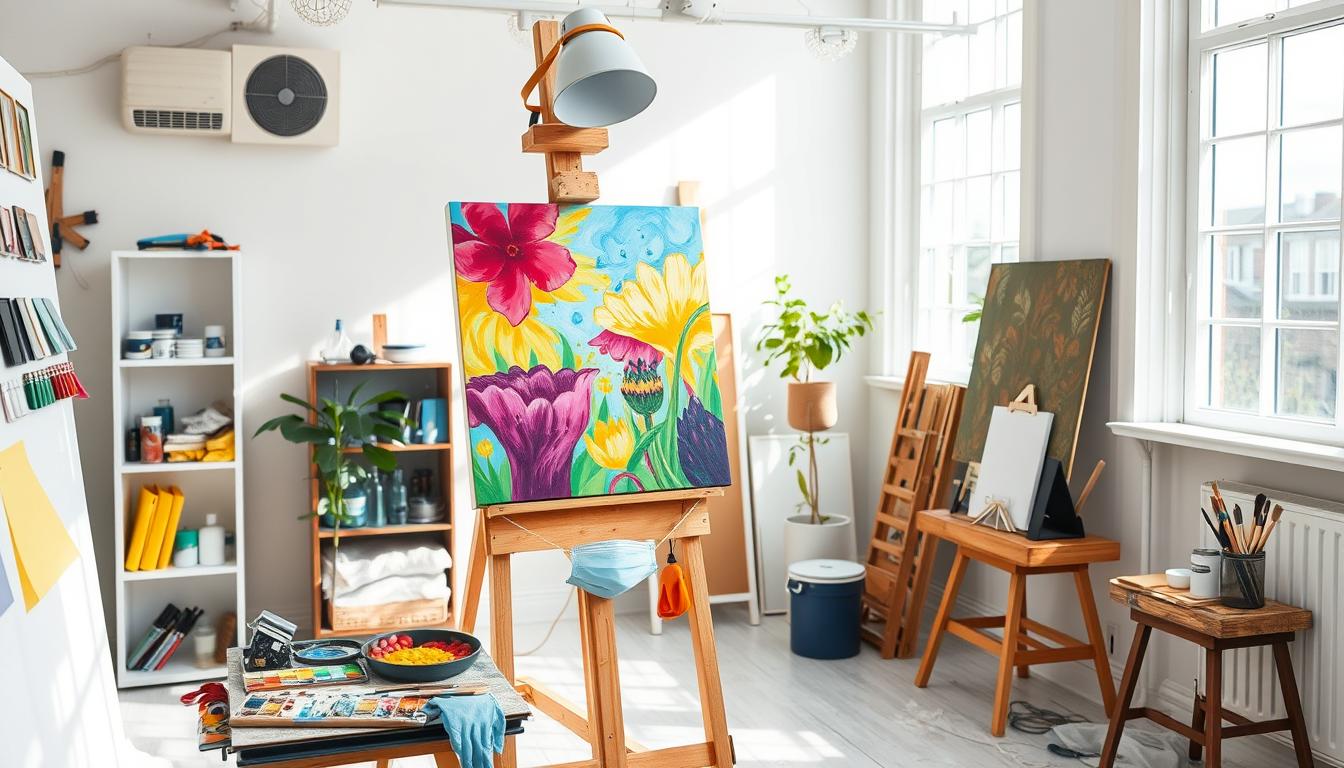This post contains affiliate links.
Imagine diving into the colorful world of acrylic painting. Your canvas bursts with vivid hues and delicate patterns. Both beginners and experienced artists find this medium great for expressing creativity. But, remember to consider health risks to keep the experience safe and fun. The dangers of painting have been known since 1713, showing how crucial safe practices are.
Being around acrylic paint, especially some pigments and solvents, might harm your health if you’re not careful. Skin irritation or worse, like contact dermatitis or more critical conditions, can occur. It’s important for both hobbyists and professionals to know what’s in their paints. They should also ensure good air flow and wear the right protective gear while painting.
Key Takeaways
- The health hazards of painting have been recognized since 1713, highlighting the long-standing awareness of these risks.
- Proper handling of acrylic paint can prevent skin irritation and other allergic reactions.
- Choose non-toxic and low fume products to reduce health issues.
- Ensure adequate ventilation to minimize inhalation of harmful fumes.
- Employ safe disposal practices to protect the environment and your wellbeing.
By following these health tips, you do more than protect yourself. You also make your art journey richer. Let’s dive into these safety guidelines and practices together.
Acrylic Painting Overview: Benefits and Risks
Acrylic painting is known for being flexible and diverse. Artists everywhere love it for its vast techniques and styles. With acrylics being the top choice globally, it’s clear why it attracts both new and experienced artists. These paints offer many advantages but also come with their risks.
Flexibility and Versatility of Acrylics
Acrylic paints strike a perfect balance. They’re as easy to use as watercolors and as bold as oil paints. Their water-based nature means artists can use them in many ways. They work on almost any surface, such as canvas, wood, metal, or fabric. Acrylics are also durable, perfect for indoor and outdoor art without damage.
In the last 50 years, there’s been confusion about acrylic paints. If artists learn about their many uses, they can really boost their art. This is shown well in this guide for beginner painters.
Quick Drying Time Challenges
One big plus of acrylic paint is how fast it dries. This lets artists add layers quickly, perfect for those wanting fast results. But, this can be tricky too. The paint dries so fast, blending and tweaking it must be done quickly. Unlike oil paints, which stay wet longer, acrylics need speed and care.
But, safety with acrylic paint is important too. They are safer than oil paints because they are water-soluble and not toxic. Still, some parts can be harmful. For example, formaldehyde in the paint can harm the liver and cause cancer. Also, acrylics can contain microplastics, which is bad for the planet. It’s key for artists to know these risks.
Artists can also get more from acrylics by knowing them better. Being safe and aware of the dangers can make painting more enjoyable. This keeps both the artist and the environment safe.
Understanding Acrylic Paint Composition
Since the 1950s, acrylic paints have grown popular in the art world. They come in over 90 vibrant colors, loved by many artists. This section explores what acrylic paint is made of.
Water-Based Nature
Acrylic paints are water-based. This means you can clean them up with soap and water. You don’t need harmful chemicals like with oil paints. They also dry quickly, usually in about 30 minutes.
Water-based acrylics last a long time. Their acrylic resin binder keeps colors bright and prevents damage. This makes them both easy to use and long-lasting.
Non-Toxic vs. Toxic Components
Many acrylic paints are safe, non-toxic, and ok to use around kids and pets. But beware of some paints with heavy metals like Cadmium, Cobalt, or Chromium. These can be cancer risks, as the labels warn.
Products like spray paints and varnishes can be even more dangerous if breathed in. Always use in a well-ventilated area or wear a mask. Materials like polyester or epoxy resin can also be harmful if you breathe their vapors for too long.
It’s crucial for artists to know these risks. This helps them stay safe and make smart choices about materials and safety.
| Type | Main Characteristics | Cleanup | Drying Time |
|---|---|---|---|
| Acrylic Paints | Water-based, quick-drying, non-toxic options available | Soap and water | About 30 minutes to touch |
| Oil Paints | Rich color, slow-drying, requires toxic chemicals | Solvents like turpentine | 6-8 hours to touch |
Choosing the right art materials is important. Knowing the difference between safe and toxic paints helps.
Acrylic Paint Fumes Protection
Acrylic paints are loved for being non-toxic and versatile. Still, it’s important to watch out for fumes. Ensure you work in ventilated areas and choose paints with less smell, especially in small rooms.

Importance of Proper Ventilation
Paints can release compounds that irritate your eyes, nose, and throat. They can also cause headaches, dizziness, and nausea. It’s vital to ventilate your workspace well when painting, even with low-odor products, to avoid these issues.
Bad ventilation may lead to short-term and possibly long-term health troubles. Research shows paint fume exposure while pregnant could harm the baby. Therefore, make sure your painting area is airy and safe.
Low Fume Products
Choosing paints with lower odor can cut down on harmful vapors. Acrylics generally emit fewer VOCs than oil paints, which is better for indoor painting. Always check for safety information on labels and pick those with the least VOCs.
It’s smart to use paints meeting strict safety rules, like those by the ACMI or marked “Conforms to ASTM D4236”. Look for these labels to ensure you’re using safe materials. Proper airing and low-fume paints make painting safer and more pleasant.
| Acrylic Paint Safety Tips | Description |
|---|---|
| Proper Ventilation | Ensure adequate air circulation when painting to minimize the risk of inhaling fumes. |
| Low Odor Acrylics | Select paints with low VOC emissions to reduce the exposure to harmful chemicals. |
| Check Labels | Look for products that conform to recognized safety standards for added assurance. |
| Safety Gear | Use protective clothing and masks to prevent skin contact and inhalation of particles. |
Safe Practices for Acrylic Painting
Embracing safe practices for acrylic painting makes for a healthier, more productive workspace for artists. It’s crucial for artists to protect themselves properly. By wearing nitrile-coated gloves, artists can avoid skin absorption of harmful substances. These substances include propylene glycol, ammonia, and formaldehyde present in some paints.
Another key safety measure is to ensure proper airflow. Opening a window or running an exhaust fan is advisable when painting with acrylics. This helps get rid of dangerous fumes that arise as the paint dries. Even non-toxic paints can release substances that are best dispersed with good ventilation.
Using specific areas for painting is also a wise move. A special painting table or easel can prevent accidental spills elsewhere. A neat, organized painting space lowers the chance of breathing in or swallowing harmful paint pigments.
| Safe Painting Practices | Benefits |
|---|---|
| Wearing Nitrile-Coated Gloves | Prevents absorption of toxic substances |
| Maintaining Proper Ventilation | Reduces inhalation of harmful fumes |
| Using Dedicated Painting Surfaces | Limits contamination and maintains cleanliness |
| Cleaning Workspace Regularly | Prevents buildup of hazardous materials |
Correct disposal of painting materials is another crucial safety step. One should never dump acrylic wastewater down the drain as it harms the environment. Cleaning your space thoroughly stops dangerous substances from accumulating.
Last but not least, keeping up with safety information is essential for artist’s health. Paying attention to health tips for artists and product labels is important. Look for warning symbols, like the European mark for dangerous substances or California Proposition 65 warnings. This awareness helps in avoiding health hazards.
Acrylic Painting Health and Safety Tips
When you paint with acrylics, it’s crucial to keep health and safety first. Using protection like masks and goggles is important. This is especially true when airbrushing. It helps avoid breathing in dangerous paint bits.

Make sure to paint in places with lots of fresh air. Good airflow gets rid of harmful fumes, according to Liquitex. Since acrylic paint is water-based, it’s safer than oil-based paints which have more risks.
Understanding the health aspects of what you’re using is key. Liquitex products, for example, are safe as per US laws. They even get a special seal that shows they’ve passed safety tests.
Let’s go over important safety steps for acrylic painting:
- Wear protective items like gloves and aprons to reduce skin exposure.
- Keep paint away from your skin, especially for kids, as some colors might harm.
- Ensure your painting area is well-ventilated to avoid breathing in fumes.
- Always follow the safety directions given on paint labels for safe use.
- Keep paints out of reach from kids and pets to dodge accidents.
If paint is accidentally swallowed or gets on the skin, act fast. Calling Poison Control at 1-800-222-1222 or using their online tool, webPOISONCONTROL, can help a lot. Knowing and following these tips will make painting with acrylics both fun and safe.
Minimizing Health Risks in Acrylic Painting
In acrylic painting, it’s crucial to minimize health risks. Artists should use safe materials and protect themselves from dangers.
Using Protective Gear
Wearing protective gear for painting cuts down on harmful exposure. The Art and Craft Materials Institute in Boston says all Liquitex products are checked for safety. Products with the ACMI’s seal or “Conforms to ASTM D4236” label are safe to use.
Gloves are important to prevent toxic materials from touching your skin. NIOSH-approved respirators are recommended for airborne materials. Dust masks help, but not against solvents. Aprons can keep paint off your clothes, adding more protection.
Choosing Safe Painters’ Tools
Choosing safety tools for artists is also key. Look for materials with the ACMI’s AP Seal or labeled under Proposition 65. These items are checked by experts and are safe. The ASTM D4236 label means the product meets safety standards and lists any hazards.
Good studio ventilation is important too. It helps clear out harmful air, bringing in fresh air. This reduces the risk from vapors and particles in paint.
By using protective gear for painting and picking certified materials, artists can safely focus on creating their art.
Proper Disposal of Acrylic Paint Materials
Disposing of paint materials properly is key to protecting the environment. It also ensures we follow regulatory guidelines. Artists must be careful when throwing away paint and other art supplies to avoid harming the environment.
The EPA and local authorities have rules for getting rid of waste. Acrylic paint, which many artists use, can be harmful, especially with dangerous pigments like cadmium oxides. It’s important to manage these materials carefully to prevent pollution.
Here are some eco-friendly tips for disposing of art supplies:
- Choose products with the ACMI’s Approved Product Seal, indicating safety.
- Pick Liquitex or Golden paints for their adherence to safety standards.
- Don’t pour rinse water down the sink. Let it evaporate or use filters and chemical reagents to clean it first.
- Keep powdered reagents dry in sealed plastic buckets.
Small amounts of solvents can evaporate. For larger amounts, treat them as hazardous waste. By following these guidelines, we protect the environment and meet safety standards.
Artists reduce their environmental footprint by properly disposing of materials. Adopting good disposal methods and eco-friendly products keeps our studios and the planet safer.
Importance of Safety Measures in Acrylic Painting
Acrylic painting is popular, but safety is key. Artists need to follow necessary safety measures in acrylic painting to stay safe and healthy. This helps avoid health risks from the materials used.
Protecting Your Skin
Skin protection is a top priority in safety measures in acrylic painting. Wearing gloves and aprons shields you from paint and mediums. These steps cut down on skin contact with harmful chemicals and block toxin absorption.
Materials with cadmium pigments and lead pose serious risks, such as nerve and kidney damage. Labels like Approved Product (AP) and Cautionary Labeling (CL), granted after safety checks by ACMI (Art and Creative Materials Institute), indicate safe use when directions are followed.
Having an Emergency Plan
Having a painting emergency plan is also crucial. Being prepared limits harm from accidents. Knowing how to deal with skin reactions or swallowed paint is key. Keeping a first-aid kit handy and knowing the Hazard Communication Standard: Safety Data Sheets from OSHA are important. These sheets offer detailed info on ingredients and hazards.
Proper studio ventilation is vital. It brings in fresh air and removes harmful one. These safety measures in acrylic painting, including the painting emergency plan, keep artists safe while they enjoy creating. For more safety tips, the University of Chicago’s guidelines on art studio safety are a great resource.
Acrylic Painting Ventilation Best Practices
Having good acrylic painting ventilation is key for health in art studios. Acrylic paints release substances like water, propylene glycol, and ammonia. So, good ventilation is a must. It makes painting safer and more enjoyable.
- Using Fans: Fans improve air circulation a lot. They spread out air particles, cutting down on breathing in toxins.
- Opening Windows: Open windows bring in fresh air. This gets rid of bad fumes in your workspace.
- Ventilated Work Areas: Try to work in places built for good airflow. This means using exhaust fans or air purifiers specially made for this.
Recently, artists are choosing not to use solvents. For example, moving to solvent-free types of paint has helped artists avoid harmful solvents. Mary Tevlin, a product expert, supports this change. And some acrylics give off formaldehyde while drying. This shows again how vital proper ventilation is.
- Regularly Check for Hazardous Components: Check paint labels for dangerous chemicals like cadmium or manganese. Choose safer options.
- Dispose of Waste Correctly: Properly get rid of hazardous waste. Use special disposal sites to avoid harm to the environment.
For those working with oils or encaustics, be careful with solvents like turpentine. They can harm your skin and lungs over time. Opting for solvent-free products, like Gamblin’s gel, or natural thinners, is healthier. These include lavender spike oil or citrus options.
Improving air flow in your studio through better ventilation benefits both your art and health. For more tips on choosing between acrylics and other paints, check out this helpful article on acrylic versus oil painting.
Common Mistakes and How to Avoid Them
Many artists face problems with acrylic painting that can affect their art’s quality and lifespan. We will discuss these common issues and give tips to make your painting process better and enjoyable.
Incorrect Mixing Ratios
One frequent mistake is not mixing paint and medium correctly. Wrong ratios can change how long it takes to dry and how your piece looks in the end. Always use the manufacturer’s recommendations when mixing to prevent the paint from being too fluid or too thick.
If you’re engaged in acrylic pouring, adherence to precise paint-to-pouring medium ratios is critical to avoid issues like paint being either too runny or insufficiently fluid.
Maintaining the right ratios is key for the right consistency and a better finish on your painting.
Improper Handling of Wet Paint
Another issue is not dealing with wet paint correctly. Safe handling is vital to prevent smears and damage. The drying time for acrylic paint varies with paint thickness and humidity.
Being patient is crucial during drying to ensure your artwork turns out well.
| Factor | Drying Time |
|---|---|
| Thin Layers | 2-3 hours |
| Thick Layers | Up to 2 days |
Following the right drying times avoids extra fixes and keeps your painting’s quality. Also, wearing gloves and keeping the area well-ventilated can help handle wet paint better.
Conclusion
Reflecting on key points about acrylic painting health and safety, it’s clear that being careful and informed makes a big difference. Following safety tips is crucial, especially with harmful substances. This keeps the art-making process fun and safe. Knowing the dangers of materials like cadmium helps artists avoid health risks.
Using the right painting methods and keeping the air fresh greatly lowers risks from chemicals. Wearing the correct safety gear and choosing safe tools helps protect against harmful effects. For more tips, check out cool painting ideas here.
Putting safety first in acrylic painting is essential. Detailed health and safety tips keep both the artwork and the artist healthy. Last thoughts about painting safely stress the need to be informed and careful. With the right knowledge, artists can dive into their work safely, creating stunning and safe art.
FAQ
What are essential health tips for safe acrylic painting?
What benefits does acrylic paint offer, and what risks should artists be aware of?
What is the role of ventilation in acrylic painting, and how can artists ensure proper airflow?
What are the differences between non-toxic and toxic acrylic paints?
How can artists minimize health risks associated with acrylic painting?
Why is proper disposal of acrylic paint materials important, and how should it be done?
What safety measures should be taken to protect the skin during acrylic painting?
Why is having an emergency plan important in acrylic painting?
What are the best practices for ensuring proper ventilation in the painting area?
What are common mistakes in acrylic painting and how can they be avoided?
This post contains affiliate links.

